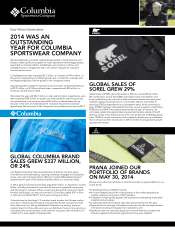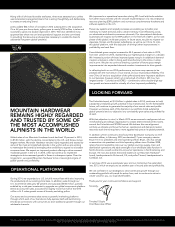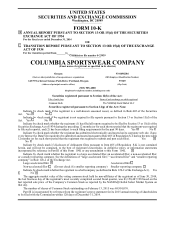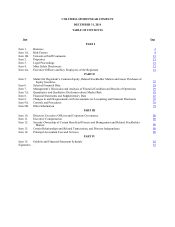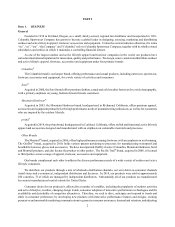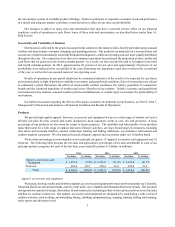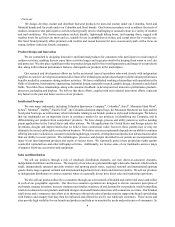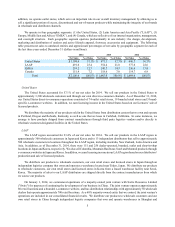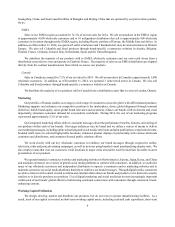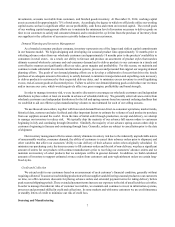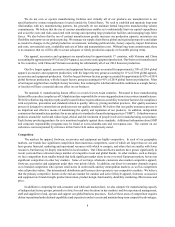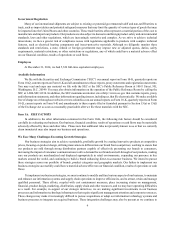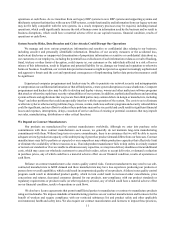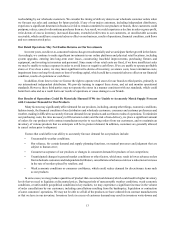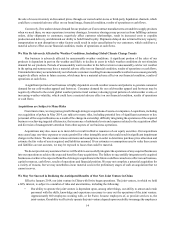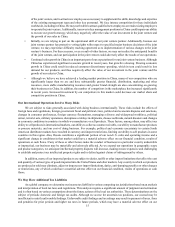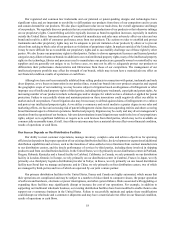Columbia Sportswear 2014 Annual Report Download - page 12
Download and view the complete annual report
Please find page 12 of the 2014 Columbia Sportswear annual report below. You can navigate through the pages in the report by either clicking on the pages listed below, or by using the keyword search tool below to find specific information within the annual report.8
We do not own or operate manufacturing facilities and virtually all of our products are manufactured to our
specifications by contract manufacturers located outside the United States. We seek to establish and maintain long-term
relationships with key manufacturing partners, but generally do not maintain formal long-term manufacturing volume
commitments. We believe that the use of contract manufacturers enables us to substantially limit our capital expenditures
and avoid the costs and risks associated with owning and operating large production facilities and managing large labor
forces. We also believe that the use of contract manufacturers greatly increases our production capacity, maximizes our
flexibility and improves our product pricing. We manage our supply chain from a global and regional perspective and adjust
as needed to changes in the global production environment, including political risks, factory capacity, import limitations
and costs, raw material costs, availability and cost of labor and transportation costs. Without long-term commitments, there
is no assurance that we will be able to secure adequate or timely production capacity or favorable pricing terms.
Our apparel, accessories and equipment are manufactured in approximately 17 countries, with Vietnam and China
accounting for approximately 68% of our 2014 apparel, accessories and equipment production. Our footwear is manufactured
in five countries, with China and Vietnam accounting for substantially all of our 2014 footwear production.
Our five largest apparel, accessories and equipment factory groups accounted for approximately 30% of 2014 global
apparel, accessories and equipment production, with the largest factory group accounting for 11% of 2014 global apparel,
accessories and equipment production. Our five largest footwear factory groups accounted for approximately 85% of 2014
global footwear production, with the largest factory group accounting for 41% of 2014 global footwear production. Most
of our largest suppliers have multiple factory locations, thus reducing the risk that unfavorable conditions at a single factory
or location will have a material adverse effect on our business.
We maintain 11 manufacturing liaison offices in a total of seven Asian countries. Personnel in these manufacturing
liaison offices are direct employees of Columbia and are responsible for overseeing production at our contract manufacturers.
We believe that having employees physically located in these regions enhances our ability to monitor factories for compliance
with our policies, procedures and standards related to quality, delivery, pricing and labor practices. Our quality assurance
process is designed to ensure that our products meet our quality standards. We believe that our quality assurance process is
an important and effective means of maintaining the quality and reputation of our products. In addition, independent
contractors that manufacture products for us are subject to standards of manufacturing practices (“SMP”). Columbia sources
products around the world and values legal, ethical and fair treatment of people involved in manufacturing our products.
Each factory producing products for us is monitored regularly against these standards. Additional information about SMP
and corporate responsibility programs may be found at www.columbia.com and www.prana.com. The content on our
websites is not incorporated by reference in this Form 10-K unless expressly noted.
Competition
The markets for apparel, footwear, accessories and equipment are highly competitive. In each of our geographic
markets, our brands face significant competition from numerous competitors, some of which are larger than we are and
have greater financial, marketing and operational resources with which to compete, and others that are smaller with fewer
resources, but that may be deeply entrenched in local markets. Our China and Korea markets have grown significantly in
recent years and have attracted a large number of competitive local and global brands. In other markets, such as Europe,
we face competition from smaller brands that hold significant market share in one or several European markets, but are not
significant competitors in other key markets. Some of our large wholesale customers also market competitive apparel,
footwear, accessories and equipment under their own private labels. In addition, our direct-to-consumer channels expose
us to branded competitors who operate retail stores in outlet malls and key metropolitan markets, as well as competitors
who sell product online. Our international distributors and licensees also operate in very competitive markets. We believe
that the primary competitive factors in the end-use market for outdoor and active lifestyle apparel, footwear, accessories
and equipment are brand strength, product innovation, product design, functionality, durability, marketing effectiveness and
price.
In addition to competing for end-consumer and wholesale market share, we also compete for manufacturing capacity
of independent factory groups, primarily in Asia; for retail store locations in key markets; and for experienced management,
staff and suppliers to lead, operate and support our global business processes. Each of these areas of competition requires
distinct operational and relational capabilities and expertise in order to create and maintain long-term competitive advantages.


